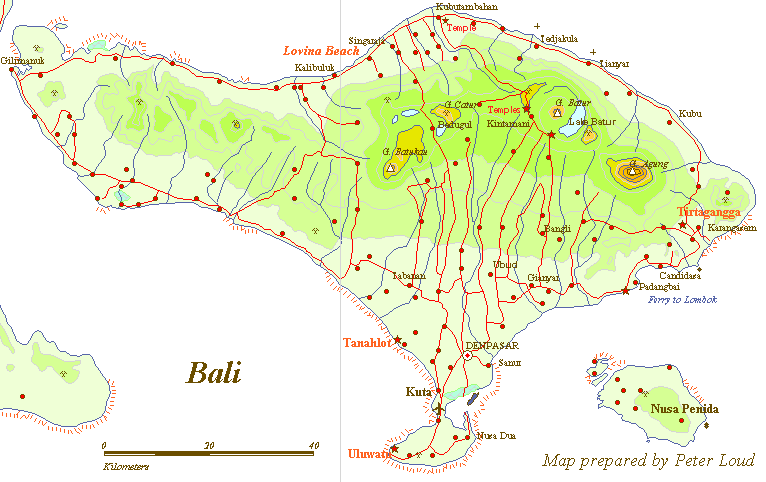The First Interactive Virtual Tourism Centre on the GTPNet
developed by UNTPDC in cooperation with PUSDATA and Bali Trade Point
![]() Geography... Bali is part of the Republic of Indonesia, and lies only
about 8 degrees south of the equator, in the Indian Ocean, to the east
of the Java and north-west of Australia.
Geography... Bali is part of the Republic of Indonesia, and lies only
about 8 degrees south of the equator, in the Indian Ocean, to the east
of the Java and north-west of Australia.
Measuring only 140km by 80km (area 5620 sq km), the island is dominated by a series of towering volcanos that range its entire width. The tallest is Gunung Agung (over 3000m), which is revered as the holy "Mother temple".
Tropical rainfall, consistant temperatures and the rich volcanic soil provide an ideal environment for intensive agricultural activity including rice, coffee, copra, and vegetable growing, as well as cattle herding.
Bali is in the Central Indonesia Standard Time zone, and is GMT plus 8 hours.

 Climate
and weather... Bali is located near to the equator, and has a tropical
climate, with year-round maximum temperatures typically ranging from 32
to 35 degrees Celcius, but with high humidity levels during the hot wet
season. Rain can be expected at any time, even during the dry season,
however an overnight shower is generally refreshing, and usually washes
away the dust. A cooling breeze that often springs up of an evening
makes a brilliant tropical day seem perfect.
Climate
and weather... Bali is located near to the equator, and has a tropical
climate, with year-round maximum temperatures typically ranging from 32
to 35 degrees Celcius, but with high humidity levels during the hot wet
season. Rain can be expected at any time, even during the dry season,
however an overnight shower is generally refreshing, and usually washes
away the dust. A cooling breeze that often springs up of an evening
makes a brilliant tropical day seem perfect.
![]() Click here
to see our Bali weather chart.
Click here
to see our Bali weather chart.
![]() Plants...
The most holy of trees, the banyan, grows to a massive size, and may
have hundreds of creepers hanging from its branches. They grow in many
of the lowland rainforests, and are a feature of most temples.
Plants...
The most holy of trees, the banyan, grows to a massive size, and may
have hundreds of creepers hanging from its branches. They grow in many
of the lowland rainforests, and are a feature of most temples.
Palm trees line the beaches, yielding fruit such as coconuts as well as sugar, fibre, oil and fuel. In Bali, the coconut palm is said to be the most useful of all trees, providing food, drink, firewood, timber and leaves suitable for making a shelter.
The heady smell of frangipani flowers make up for all of the less favorable odours that are typically experienced in Asian cities, and the shady frangipani trees are grown almost everywhere in Bali.
Bamboo, bananas, hibiscus, bougainvillaea, oleander, jasmine, water-lillies and lotus may be seen growing wild, as well as in plantations and gardens throughout the island.
Rice fields dominate the landscape, especially in the lower foothills south of the central mountains, and provide spectacular and scenic views when seen from the winding mountain roads.
![]() Dogs... The
first animal that is sighted by any visitor to Bali is invariably a dog
of the local variety, usually seen carrying out one of its ritual
practices of sniffing piles of rubbish, marking its territory or lying
down in the centre of the footpath. These generally mangy, scabby and
ugly creatures are not treated with affection by anybody in Bali, but
seem to live their lives around the streets in bliss despite that.
Dogs... The
first animal that is sighted by any visitor to Bali is invariably a dog
of the local variety, usually seen carrying out one of its ritual
practices of sniffing piles of rubbish, marking its territory or lying
down in the centre of the footpath. These generally mangy, scabby and
ugly creatures are not treated with affection by anybody in Bali, but
seem to live their lives around the streets in bliss despite that.
![]() Other
animals... Monkeys will be seen in most temples, demanding peanuts, as
well as in several of the forests, including the famous tourist spots
on the way to Tanah Lot and in Ubud. Other wild animals include bats
and lizards (such as the small cream colored cecaks that seem to
inhabit most the walls of rooms, and the larger geckos, whose call of
"geck-oh" is a familiar part of the evening soundscape.
Other
animals... Monkeys will be seen in most temples, demanding peanuts, as
well as in several of the forests, including the famous tourist spots
on the way to Tanah Lot and in Ubud. Other wild animals include bats
and lizards (such as the small cream colored cecaks that seem to
inhabit most the walls of rooms, and the larger geckos, whose call of
"geck-oh" is a familiar part of the evening soundscape.
Many domestic animals are seen all over the island, including ducks fossicking in the rice fields (a form of natural pest control), cows, pigs and chickens.
The birds of Bali are seen mainly outside of the cities and villages. Parrots and other brightly colored birds are not seen too frequently but are impressive sights when spotted. Near to Ubud is the village of Petulu, where each evening, thousands of white herons arrive to perch in the trees that line the main road.
Return to our Bali: The Online travel guide index.
Copyright © 1995, Wayne Reid (wreid@werple.mira.net.au). All rights reserved. No part of this publication may be reproduced in any way without the permission of the author.
Last updated: May 19th 1996